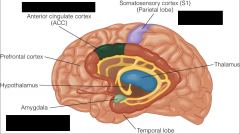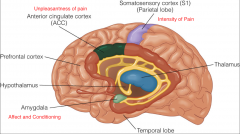![]()
![]()
![]()
Use LEFT and RIGHT arrow keys to navigate between flashcards;
Use UP and DOWN arrow keys to flip the card;
H to show hint;
A reads text to speech;
42 Cards in this Set
- Front
- Back
|
Somatosensory system |
The somatosensory system has both interoceptive and exteroceptive functions. 4 main components of the somatosensory system are: Nocioception, Hapsis, Proprioception, Balance. |
|
|
Nocioception |
The perception of pain and temperature. |
|
|
Hapsis |
The perception of objects using touch and pressure. |
|
|
Proprioception |
Knowledge of the position of your limbs in space. |
|
|
Balance |
Controlled by the vestibular system in the inner ear. |
|
|
Skin |
One of the largest organs in our body. Contains receptors for pain and touch. Also important for keeping bacteria, viruses etc., out. |
|
|
Epidermis |
Is the skins outermost layer. Comprised of dead skin cells. Contains mechanoreceptors. |
|
|
Dermis |
Below the epidermis. contains mechanoreceptors. |
|
|
Subcutaneous |
Below the dermis |
|
|
Rapidly adapting receptors |
Respond quickly to sudden changes, but adapt quickly. |
|
|
Slowly adapting receptors |
If you push down hard on your arm, the receptors do not adapt as quickly. |
|
|
Mechanoreceptors |
Sensory receptors that respond to pressure, stretch or vibration. |
|
|
The spinal cord and dermatomes |
Receives afferent sensory information from nerves in the body part adjacent to it. |
|
|
Dorsal column medial lemniscal system (dorsal column system) |
Fine touch and proprioception |
|
|
Spinothalamic tract (spinothalamic system) |
Pain and temperature. |
|
|
Plasticity in cortical body maps |
Jenkins and Merzenich exposed monkeys to repeated tactile stimulation of the index fingertip for 3 months. Repeated sensory stimulation caused an increase in the amount of tissue processing information from that part of the body. |
|
|
Phantom limb |
After amputating a limb, some patients claim that they can still feel their limb. Some even feel sensations on the phantom limb when another body part is stimulated. |
|
|
Tactile acuity |
A measure of how precisely people can perceive detailed tactile information. 2 methods generally used, two point discrimination, and grating acuity. |
|
|
Merkel's receptors |
Are important for perceiving fine details. HIgh concentration on the fingertips. Slow adapting. |
|
|
Pacinian corpuscles |
Are important for coding vibration and touch. Fast adapting. |
|
|
Acuity and receptor spacing |
Acuity is linked both to the type of receptor as well as the spacing between receptors. The smaller the spacing between receptors, the greater the acuity. |
|
|
Receptive field |
The location on the skin that, when stimulated causes the receptor to fire. Cortical neurons in S1 have receptive fields that differ in size depending on which part of the body is represented. Cortical magnification. |
|
|
Perceiving vibration: Pacinian corpuscles |
Pacinian corpuscles respond well to high frequency indentation which makes them sensitive to vibration. |
|
|
Duplex theory of texture perception |
Suggests that texture perception relies on spatial and temporal cues. |
|
|
Spatial cues |
How the surface elements are spaced with respect to one another. Works well for larger features. |
|
|
temporal cues |
Vibrations that occur when skin moves across a fine surface. |
|
|
Hollins and Reisner exp. |
Had participants judge the roughness of two fine surfaces using magnitude estimation. The ability to distinguish between two surfaces increased when they were allowed to move their fingers across it. Relies mostly on signals from pacinian corpuscles. |
|
|
Active touch |
Exploring an object by moving it around in your hands. |
|
|
Passive touch |
Passive stimulation without active exploration. |
|
|
Haptic perception |
Exploration of 3D objects with the hand. requires the interaction between the sensory system, motor system and cognition. |
|
|
Tactile agnosia |
Inability to recognize objects using tactile input. Very rare, usually results from lesions in somatosensory association cortex. |
|
|
Apperceptive tactile agnosia |
Cannot copy items using tactile information |
|
|
Associative tactile agnosia |
Can copy, but still cannot identify items from tactile information |
|
|
Nocioceptive pain |
Pain caused by activation in the free nerve endings in the skin. |
|
|
Direct pathway model |
Assumed that pain responses were created in receptors in the skin and were sent directly to the brain. |
|
|
Problems with the direct pathway model |
Pain can occur when there is no stimulation on the skin (phantom limb). Pain can be influenced by attention (some people do not know they are injured until their attention is directed towards it.) |
|
|
Gate control model of pain |
Pain signals enter the spinal cord and are sent to S1. Additional pathways can act as a 'gate' to increase or decrease pain signals leaving the spinal cord. Substantia gelatinosa (SG) |
|
|
S fibers |
Carry pain signals from nocioceptors |
|
|
L fibers |
Carry info about tactile stimulation |
|
|
T cells |
Transmit pain signals to the brain |
|
|
Central control |
Signals coming from the brain to help reduce pain sensation, attention and hypnosis. |
|

|

|

